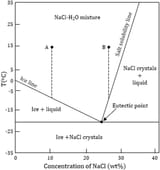Ideas for desalination
Some years ago I was reading some papers about desalination, and I read that, when frozen, most salt water becomes fresh water, i.e., the salt separates. Then I read about cascaded desalination systems that use heat, and how heating water is actually much more energy-intense than freezing it (specific heat for ice is like half of that of water), and boiling water uses even more energy.
On the other hand, freezing water is more expesinve than reverse osmosis.
All of the above made me think: why aren't there cascaded desalination systems that reuse the differential in temperatures to separate the salt from seawater? Like, you could have a system where seawater is frozen into ice, and heat is transferred from the input water to the ice in a sequential (cascaded) process designed in a way that little energy is lost. Also, heat pumps would make it so that you would be moving heat away from the system for cheap.
Let's say the output ice is at -20°C, and the input seawater is at 20°C. You could transfer heat from seawater at 0°C to ice -20°C, then seawater at 10°C to ice at -6°C, and seawater at 20°C to fresh water at 5°C, and that would be 3 stages. You could have intermediate stages. Maybe even a continuous flow of some sort. Do you think this would save enough energy to make the system worth making?
Here's some reading material: https://www.nature.com/articles/s41545-022-00158-1
On the other hand, freezing water is more expesinve than reverse osmosis.
All of the above made me think: why aren't there cascaded desalination systems that reuse the differential in temperatures to separate the salt from seawater? Like, you could have a system where seawater is frozen into ice, and heat is transferred from the input water to the ice in a sequential (cascaded) process designed in a way that little energy is lost. Also, heat pumps would make it so that you would be moving heat away from the system for cheap.
Let's say the output ice is at -20°C, and the input seawater is at 20°C. You could transfer heat from seawater at 0°C to ice -20°C, then seawater at 10°C to ice at -6°C, and seawater at 20°C to fresh water at 5°C, and that would be 3 stages. You could have intermediate stages. Maybe even a continuous flow of some sort. Do you think this would save enough energy to make the system worth making?
Here's some reading material: https://www.nature.com/articles/s41545-022-00158-1


